#i wanted to print that same design on the cd itself but i don't think my printer will do that...
Explore tagged Tumblr posts
Text
MY DINOSAUR LIFE ~ MOTION CITY SOUNDTRACK
Earlier this week, I bought myself two CDs - I Am The Movie, and My Dinosaur Life. Both are by Motion City Soundtrack, a band I don't think I can really actually express my love for adequately. When I say that I was so excited to get my hands on these albums I had to use my inhaler, I'm not actually exaggerating. Anyway, My Dinosaur Life has really quickly become my favourite CD I own, and I really gotta gush about it before I ultimately implode under the pressure of keeping it all in, and what better place than here I thought! I won't talk about the songs, this is specifically about the CD and art etc.
First of all, here is the back and front of the CD case! The part that reads MOTION CITY SOUNDTRACK is actually a sticker on the case as opposed to being printed directly onto the album booklet. The case for I Am The Movie has a similar deal going on, but I'll talk about that another time. I'm just a fan of the little dino guy (designed by Joe Ledbetter, no less [additionally, someone that understands Wikipedia needs to add a citation to his page with regards to his work with MCS please!!])! As you can see by the back, this is the standard edition disc as far as I'm aware, it features none of the alternative versions found on the deluxe editions, and it's certainly not the Japanese release.
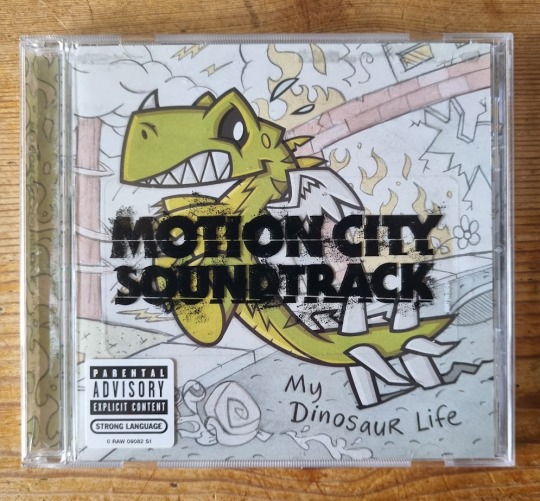

Anyway, next up: the disc itself! I'm a big fan of the disc, I think it's very sweet. I think I might have almost died when I opened it today to see this. I am a huge fan of shiny discs, but the best part came after I removed it....

As you can see, removing the disc shows the art behind the disc itself. The same dinosaur, but this time on display in a museum. I cannot understate how fantastic the graphic design of this case is, it is beautiful, and fantastic, and there is so much to see in it, wherever it is you look.
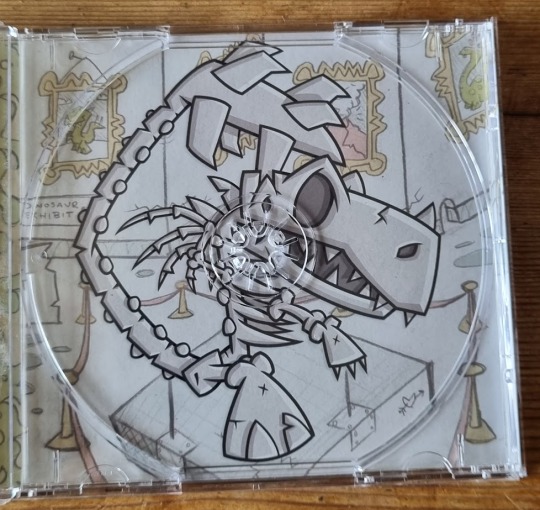
Whenever I have a CD, I usually expect that the lyrics will be in the accompanying album booklet, perhaps with some additional notes and thank yous. However for My Dinosaur Life, I was pleasantly surprised to find that instead of the lyrics was a booklet filled with art by Joe Ledbetter. Each of the artworks corresponds with each of the songs on the album, which is a fantastic touch and one that excited me even more than the bones behind the disc did. I've taken a picture of every single one of those illustrations, which are all gonna be shared here for everyone's viewing pleasure (because they're like. really really good okay).











Every single one of the art pieces is brilliant and filled with so many little references and correspond to the ideas of the songs, and I will be honest in saying I have been staring at them for a lot of time today. I wanted to make sure everyone else had the opportunity to see them as well!
Additional Information: Produced by: Mark Hoppus (of Blink 182) Mixed by: Andy Wallace (worked with Nirvana, Sepultura, System of a Down, and plenty others)
There is also a link to a website on the back of the disc. It seems the domain is now owned by someone else, however it was archived on the wayback machine if anyone is interested! It has plenty of information on the making of My Dinosaur Life, pictures, schedules (and at the bottom, it says "powered by Tumblr", which I wasn't expecting). You can access this here!
I don't really have much else to say other than there is not enough Motion City Soundtrack on here anymore and I plan to change that single handily, fuelled primarily by a very intense interest in them!
#motion city soundtrack#music#kes talks music#own post#pop punk#my dinosaur life#justin pierre#justin courtney pierre#mcs
16 notes
·
View notes
Text
Hell is terms like ASIC, FPGA, and PPU
I haven't been doing any public updates on this for a bit, but I am still working on this bizarre rabbit hole quest of designing my own (probably) 16-bit game console. The controller is maybe done now, on a design level. Like I have parts for everything sourced and a layout for the internal PCB. I don't have a fully tested working prototype yet because I am in the middle of a huge financial crisis and don't have the cash laying around to send out to have boards printed and start rapidly iterating design on the 3D printed bits (housing the scroll wheel is going to be a little tricky). I should really spend my creative energy focusing on software development for a nice little demo ROM (or like, short term projects to earn money I desperately need) but my brain's kinda stuck in circuitry gear so I'm thinking more about what's going into the actual console itself. This may get techie.
So... in the broadest sense, and I think I've mentioned this before, I want to make this a 16-bit system (which is a term with a pretty murky definition), maybe 32-bit? And since I'm going to all this trouble I want to give my project here a little something extra the consoles from that era didn't have. And at the same time, I'd like to be able to act as a bridge for the sort of weirdos who are currently actively making new games for those systems to start working on this, on a level of "if you would do this on this console with this code, here's how you would do it on mine." This makes for a hell of a lot of research on my end, but trust me, it gets worse!
So let's talk about the main strengths of the 2D game consoles everyone knows and loves. Oh and just now while looking for some visual aids maybe I stumbled across this site, which is actually great as a sort of mid-level overview of all this stuff. Short version though-

The SNES (or Super Famicom) does what it does by way of a combination of really going all in on direct memory access, and particularly having a dedicated setup for doing so between scanlines, coupled with a bunch of dedicated graphical modes specialized for different use cases, and you know, that you can switch between partway through drawing a screen. And of course the feature everyone knows and loves where you can have one polygon and do all sorts of fun things with it.
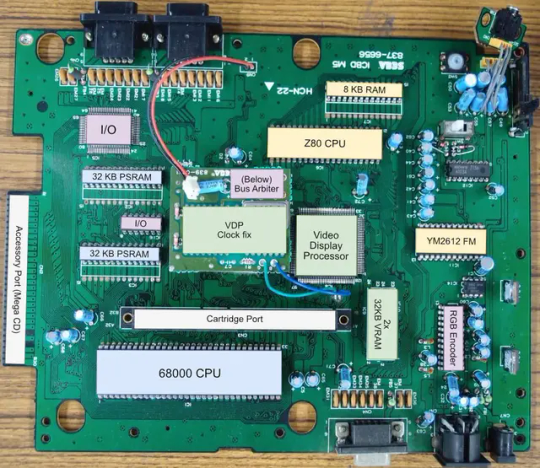
The Genesis (or Megadrive) has an actual proper 16-bit processor instead of this weird upgraded 6502 like the SNES had for a scrapped backwards compatibility plan. It also had this frankly wacky design where they just kinda took the guts out of a Sega Master System and had them off to the side as a segregated system whose only real job is managing the sound chip, one of those good good Yamaha synths with that real distinct sound... oh and they also actually did have a backwards compatibility deal that just kinda used the audio side to emulate an SMS, basically.

The TurboGrafix-16 (or PC Engine) really just kinda went all-in on making its own custom CPU from scratch which...we'll get to that, and otherwise uh... it had some interesting stuff going on sound wise? I feel like the main thing it had going was getting in on CDs early but I'm not messing with optical drives and they're no longer a really great storage option anyway.
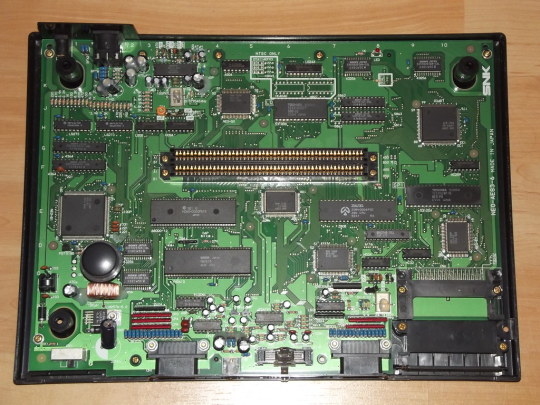
Then there's the Neo Geo... where what's going on under the good is just kind of A LOT. I don't have the same handy analysis ready to go on this one, but my understanding is it didn't really go in for a lot of nice streamlining tricks and just kinda powered through. Like it has no separation of background layers and sprites. It's just all sprites. Shove those raw numbers.
So what's the best of all worlds option here? I'd like to go with one of them nice speedy Motorolla processors. The 68000 the Genesis used is no longer manufactured though. The closest still-in-production equivalent would be the 68SEC000 family. Seems like they go for about $15 a pop, have a full 32-bit bus, low voltage, some support clock speeds like... three times what the Genesis did. It's overkill, but should remove any concerns I have about having a way higher resolution than the systems I'm jumping off from. I can also easily throw in some beefy RAM chips where I need.
I was also planning to just directly replicate the Genesis sound setup, weird as it is, but hit the slight hiccup that the Z80 was JUST discontinued, like a month or two ago. Pretty sure someone already has a clone of it, might use that.
Here's where everything comes to a screeching halt though. While the makers of all these systems were making contracts for custom processors to add a couple extra features in that I should be able to work around by just using newer descendant chips that have that built in, there really just is no off the shelf PPU that I'm aware of. EVERYONE back in the day had some custom ASIC (application-specific integrated circuit) chip made to assemble every frame of video before throwing it at the TV. Especially the SNES, with all its modes changing the logic there and the HDMA getting all up in those mode 7 effects. Which are again, something I definitely want to replicate here.
So one option here is... I design and order my own ASIC chips. I can probably just fit the entire system in one even? This however comes with two big problems. It's pricy. Real pricy. Don't think it's really practical if I'm not ordering in bulk and this is a project I assume has a really niche audience. Also, I mean, if I'm custom ordering a chip, I can't really rationalize having stuff I could cram in there for free sitting outside as separate costly chips, and hell, if it's all gonna be in one package I'm no longer making this an educational electronics kit/console, so I may as well just emulate the whole thing on like a raspberry pi for a tenth of the cost or something.
The other option is... I commit to even more work, and find a way to reverse engineer all the functionality I want out with some big array of custom ROMs and placeholder RAM and just kinda have my own multi-chip homebrew co-processors? Still PROBABLY cheaper than the ASIC solution and I guess not really making more research work for myself. It's just going to make for a bigger/more crowded motherboard or something.
Oh and I'm now looking at a 5V processor and making controllers compatible with a 10V system so I need to double check that all the components in those don't really care that much and maybe adjust things.
And then there's also FPGAs (field programmable gate arrays). Even more expensive than an ASIC, but the advantage is it's sort of a chip emulator and you can reflash it with something else. So if you're specifically in the MiSTer scene, I just host a file somewhere and you make the one you already have pretend to be this system. So... good news for those people but I still need to actually build something here.
So... yeah that's where all this stands right now. I admit I'm in way way over my head, but I should get somewhere eventually?
11 notes
·
View notes
Text
It’s enshittification all the way down
If you don’t know about Cory Doctorow’s “Enshittification of the Internet” hypothesis… please go read
In this follow up mini essay, I’m going to talk quickly about the non-news that a major TTRPG brand is working ever closer to enshittification of TTRPGs.
The Dragon Wants to Enshittify Itself (there was no Chik-fil-A)
For a long time That Dragon Game has been showing ways it will present enshittification as helpfulness for a while.
You can see enshittification as the culmination of this demotivational from Despair Inc.

If you're not part of the solution, good money can be made [renting an approximation of a solution]
This is how I see the enshittification of lots of things happening. Companies don't want to SOLVE your problem, they want to rent you an approximation of that solution. The posterchildren of this method is the Adobe Suite and Microsoft 365 (note: other corporate software has done this for aaaaaaaages but these two are big obvious examples you've likely brushed up against, and also Hello Unity! How you doin with your Enshittification???)
How do I make this claim? The long arc of That Dragon Game trying to enshittify iteslf.
Back in the dim recesses of the 90s, That Dragon Game made a version of itself so wildly needlessly complicated that they decided to make it easier by including software on a CD to do the job for you. You could make up to Level 3 characters with it, and yeah it had some issues but they didn't try make their game easier to handle just potentially sell you a tool to manage it.
Not part of the solution, prolonging the problem for profit... eTools for 3.5EDragon Game was prolonging a design problem for profit.
Then after the Dragon had crapped all over its loot pile with 2 trillion splat books in the early 00s, the Dragon decided that it needed a new cave to put a loot horde and started on 4E.
Enter the murder of Melissa Batten. Wizards had hired Joseph Batten to head up Gleemax: a project to basically create a TTRPG Social Media site. (which boy oh boy sounds like another great place for enshittification... please see Cory's analysis of TikTok, Facebook, Twitter, etc...) A lot of this project came to a screeching halt when Joseph Batten lost the plot, decided to murder Melissa (who worked a Microsoft and was clearly better than him at a lot of stuff)... but at the same time those resources were put into Insider.
What is this Insider you speak of?
Hasbro told every department "Make at least this many boats of cash or fuck off to the wilderness" in slightly more 'investor speak'. So Wizards had to think of a way to suddenly make more cash. The solution? Insider.
Insider was going to be: - a source of new material - a VTT - a marketplace - a 'place to organise games with strangers' - etc... and you would pay a subscription for it.
Is any of this ringing any bells?
This was during the 4E incarnation of The Dragon Game. In the dim heady days of the mid 00s. A whole marriage ago for this Halfling (my marriage can nearly drive in some jurisdictions! Woot! I am old...)
As far back as 2008 Wizards have been looking for ways to make subscription versions of its stuff. The Enshittification has been happening on a loooooong arc.
But Halfling, that isn't what is happening now...

How does Beyond work?
You pay a subscription to have it, you then pay for additional content on it, you can't get your stuff off it, you have to use the thing... wait, isn't this exactly what Melon Husk is trying to do with X?
Beyond enshittified TTRPG. DMGuild is another aspect of that enshittification.
But why are you talking about this now Halfling? Why this topic now?
Well, it's making the rounds of many game design spaces that Wizbros have ended their distribution and publishing deal with Penguin Random House... sure, Wizbros likely have all sorts of options for printing/publishing/distribution. But on top of this it seems set up to make it hard for small retailers: the stores where a lot of people buy their TTRPG products. Why cut off their major advocates by doing this? To wall up the garden tighter and make it easier to enshittify the scenery more.
I don't see this as 'Wizbros scouring for a better distribution publishing deal' but a deliberate move to try enshittify things more.
#wizbros are enshittifying the bed#ttrpg enshittification has been happening for ages#cory doctorow#enshittification#ttrpg#ttrpg design
0 notes
Text
4Kids Korner - Season 2 - Episode 3
I'm a bit late this week because I got caught up with work and school-related dread, but now I'm back to bring you more 4Kids products! This week we have an epic trifepic: Winx Club Magazine Issue one - the castle, Kirby Right Back at Ya - Ice Kirby (DVDouble-Shot) and Kirby Right Back at Ya - Kirby Comes to Cappy Town!
Let's start by getting the smallest one out of the way. Here's Kirby Right Back at Ya - Ice Kirby (2005)
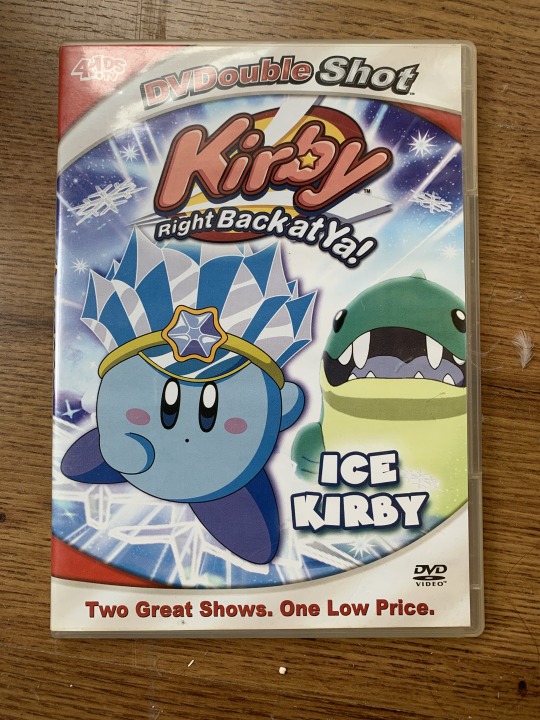


There's something I oddly like about DVDouble-Shot. Starting In 2005, the DVDouble-Shot line was introduced featuring two-Episode DVDs of 4Kids most profitable shows as a way of promoting 4Kids TV. As for the consumer, the main selling point is that you could buy them for a low price, collect and possibly trade them with your friends, kind of like Pokémon cards. I like the idea of one kid saying to the other on the playground, "hey, wanna trade your Ninja Turtles for my YuGiOh?" How successful they were, I have no idea, but they're fun and easy to review on this show. Given their small portion size, practically every DVDouble-Shot is the same. This one had the episodes "The Chill Factor" and "DeDeDe's Snow Job," in accordance with the ice theme of the disc. It also features assorted promos for then-current and upcoming 4Kids shows identical to those seen in the 4Kids TV September demo disc (which I will hopefully review some time in the future.) Before we move on, though there's one little thing I want to point out about the box art. You can't see it in the photos I've provided, but the ice monster on the cover is far more pixelated than Kirby, if you look closely at it, so it appears to me that they lifted it right out of the episode and placed it on the cover. I guess that's just what happens when no official art of a character exists for your graphic designers to use...
Now that we have that one out of the way, let's talk about the stars of today's episode, which actually turned out to have much more historical value than most of the other stuff in my collection. So say hello to the Winx Club Magazine Premiere Issue, The Castle (2005)

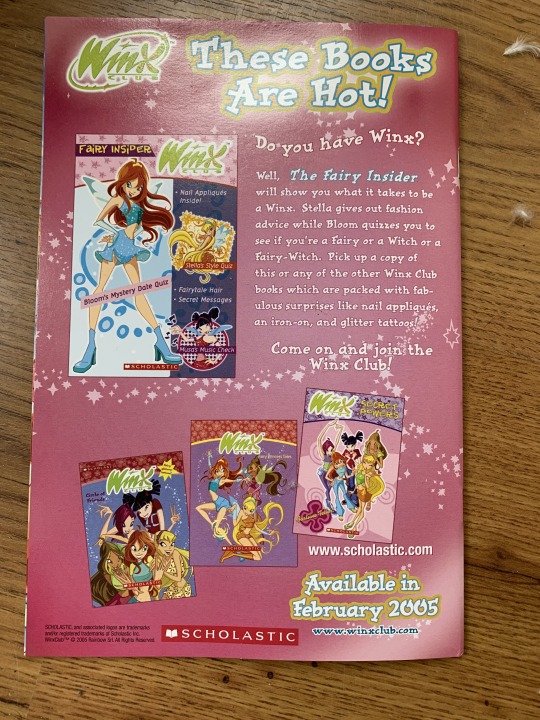

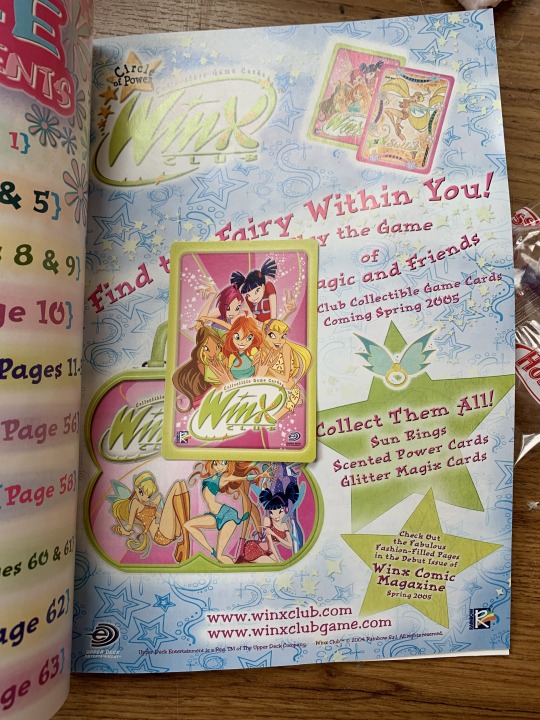
This is a very special addition to my collection not only because it's part of what I consider to be 4Kids' absolute peak year, but since the book was presumably printed in January of 2005, it means this was one of the first pieces of of merchandise to feature the now-famous 4Kids TV logo. Heck it might have even been printed before then. As for the book itself, it's quite cute as it features everything an 8-11 year old girl wanting to be a hip and trendy 2000s teenager could want, and contains surprisingly few ads for Winx Club merch. And even more adorable, is the publisher's attempts to fit that description using words like "slammin'" in sentences. I call it a magazine, but it's really more dedicated to the comic included, "The Castle," which I would have read, but I needed to get some sleep the day I read it, so I skimmed the book's numerous activities, instead. But for those still interested, the comic is a retelling of Bloom's enrollment in Alfea, with original art that's pretty accurate to the actual show. But the book's real allure is the activities. Like the free trading card you'll see in the photo above. It even comes with a full-page description of what a trading card game is, making reference to YuGiOh in the process, which I thought was funny since 4Kids owned that, and also because it heavily implies that only boys play YuGiOh when the show itself has many female duelists. After that, you have a faux interview with Bloom taken from the perspective of a fellow Alfea Student. What I remember most clearly about that, is that Bloom says she listens to top 40's, which made me think "man, she's got some trash music taste," even though I, myself have said on multiple occasions off of tumblr that I listen to basically everything. Also included on the magazine are a paper fortune-telling toy, a best friend diary which includes a "secret crush" slot to fill in, a page for writing down predictions about the reader's future, and even a personality test which assigns your traits to a type of flower, as suggested by Flora on the page. The funny thing about this is that one question asks for the reader's favorite kind of movie, and one of the options is "anime everything," which I thought was funny since anime was just starting to get big at that time in America, and the online anime community was just starting to grow. Finally, on the last page, probably the most creative of all, is a step-by-step slumber party plan by Musa, which details inviting everyone over, having them show up dressed as their favorite popstar (like Brittany Spears, for example) and bring their favorite CD from said popstar, then taking turns playing them and talking about them. It sounds quite fun, and it made me smile imagining all the little kids who tried this. That's exactly what I think is awesome about children's entertainment: it makes them happy and builds their imagination. So that's the Winx Club Magazine, a really good buy, but I must admit they used the same art of the girls more than once on a few occasions, and also wrote in a plot hole in the interview with Bloom, where she says she discovered her powers as a child, but in the show she unlocks them at her current age when saving Stella from the first monsters of the series. So it may have a couple flukes, but still quite enjoyable.
And last, but never least, it's time for Kirby Right Back at Ya: Kirby Comes to Dream Land (2002)



This one is also historically significant for two reasons. One is that it was the very first release of one of the more famous non-Pokémon/YuGiOh shows 4Kids had to offer, but it also played a part in promoting the very launch of the Fox Box, as you'll see on the box art. This disc may only have the first three episodes of the show, but it super makes up for it with a plethora of special features, more than any of the DVDs I currently own, and that they strangely enough don't tell you about on the box. And speaking of the box, though you might not see it, the episode descriptions on the back are written entirely in comic sans. Yeah, it's clear to see 4Kids wasn't quite as sharp as they would be in the next few years... and the DVD menus are also written entirely in this font. But that doesn't take away from the outstanding value. much like the Fright to the Finish DVD, this one's special features are split between two menus. For this one, there's "More Kirby" and "Added Attractions," which is the far superior one, but more on that in a minute. The More Kirby menu features a character gallary telling you about the main cast, set to music from the show. Then there's "Kirbyoke," which is there to teach the kids the words to the theme song. And finally, we have a preview for the next DVD in the series, which at that point hadn't a proper name, so Mike Pollock's voice just refers to it as "Kirby Right Back at Ya Volume 2." Then, in the "Added Attractions" menu, we have a promo for Cubix - Robots for Everyone's first DVD release, a short promo for the newly-launched FoxBox.TV website, and the star of this review by far, "What's Inside The Fox Box?!" This incredible 14 minute long promo (which you can find on Youtube, by the way,) previews every single show in the Fox Box's initial lineup as a way of hyping up the network for it's September 2002 launch. Well, kind of... You see, 4Kids made multi-minute promos for their own productions, complete with plot synopses by Mike Pollock and others and theme songs for the shows. Meanwhile, Stargate Infinity, a third-party show, only got a promo featuring still images of the main cast, a paper-thin explanation of the plot and no opening, all clocking in at under a minute. So, yeah, pretty lame move on 4Kids part, but at least we get to see HD footage of 4Kids lost Ultraman Tiga dub. Ultimately, it's a really fun promo from 4Kids' very beginnings as a dedicated children's entertainment company, even though it uses some uncut clips of guns in Fighting Foodons since the dub wasn't finished at that point. One last thing to point out: the promo for Teenage Mutant Ninja Turtles (which hadn't even started production at the time,) features an unused theme song demo for the series which also made it's way onto the illusive Fox Box CD. So there you have it, one of the DVDs that started it all. Thanks for reading about it, as well as my other items this week. I will be back with more next week, so hang in there, and I'll see you all next time. Take care!
#4Kids#4Kids TV#4Kids Anime#4Kids Dub#4Kids Entertainment#Kirby#Kirby Right Back at Ya#Kirby of the Stars#Winx Club#Books#Fox Box#DVDs#Cartoons
13 notes
·
View notes